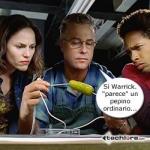
Question:
I have a RCA TV and the menu says "Language --> English". However, when watching TV, the commercials are in English and the program is in Spanish. How do I fix this?
-submitted by lump5628246
Answer:
First, if the language option in your TVs menu says English, that doesn't mean the programming you watch will be in English. This option simply dictates what language the TV's menu and on screen displays themselves will appear in. Depending on the model of the TV, you could have a variety of options here.
Now that we understand what that does, it's time to get your shows back in the right language.
Introducing SAP
Have you ever been watching a show on TV that flashes something like "SAP Transmitido en Espanol" at the bottom of the screen when the show starts? You may not have ever noticed, but this is exactly what's affecting you.
What these shows are referring to is called SAP, which is an acronym for "Second Audio Program", "Secondary Audio Program", or "Secondary Audio Programming"... depending on who you ask.
Say, for example, you're watching an episode of CSI: on CBS. CSI: is a show that's originally broadcast in English. However, many broadcasters will also transmit a second audio track for the show, which your TV has the ability to tune into. These secondary audio programs are typically a soundtrack in a different language from the original, and is most commonly a dubbed Spanish track.
You can select which audio track you'd like to listen to by adjusting a setting on your TV. Most original TV remotes have a dedicated button for switching between the primary and secondary audio track. If your remote does not have this, you should find an option in the audio menu of the TV.
Then why are commercials in English while the show is in Spanish?
If you flip your TV into SAP mode and start channel surfing, you'll undoubtedly find several programs with the normal audio track. While it is common for many broadcasters to transmit programs (particularly in prime time) with a second audio track in Spanish, there are several that don't. If the TV does not find a SAP signal to lock on to, it will use the primary audio signal by default.
Commercials rarely have SAP, so when you're watching a show in SAP mode, the TV will seemlessly switch between audio signals as SAP appears and disappears. If you didn't know SAP existed, you would have no idea what was going on.
More TV Topics Here at TechLore
What do I need to watch HDTV? - Just about everyone has heard of HDTV. Maybe you saw it at your local electronics store, heard about it from a friend, or saw an "available in HDTV" logo appear on your favorite television program. Although the HDTV buzz is spreading like wildfire, there is much to know before you can enjoy HDTV at home.
How To Find the TV that is Right for You - Today, not only are there several different types of televisions to choose from, but several different technologies as well. CRT rear-projection TVs are still based on tubes, but now there is DLP, LCD, LCoS, SXRD, and D-ILA in the projection category alone, not to mention LCD and Plasma in the flat-panel category, and they're all fighting for your hard earned dollar.
Get More Out of Your Gear
Why HDMI is the Clear Choice for HDTV Connectivity - Let's face it. The transition to HDTV has been a painful and confusing one. It's bad enough that there are now 10 different types of TV technologies available in the market, but what's worse is that display makers, content providers, set-top box manufacturers, and the entire PC industry has been pushing several completely different ways of connecting high definition components since the launch of the first HDTV products in 1998.
Home Theater's Biggest Mistakes - Home theater isn't like what you see on TV; tons of good-looking men and women dying to view a scary-real-life picture in a plush, high-tech room. Unfortunately, in the rush to reach home theater nirvana, a lot of people make mistakes that can leave them somewhere between mildly disappointed and wanting to toss the whole mess out a window.




